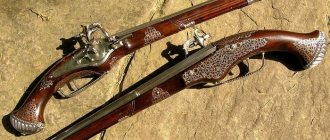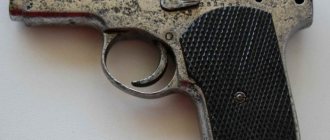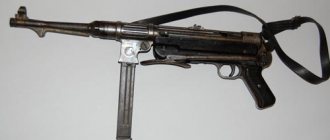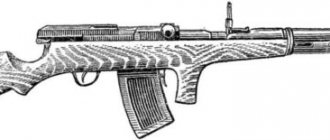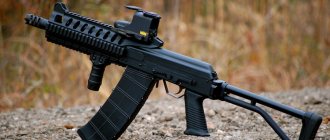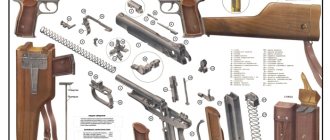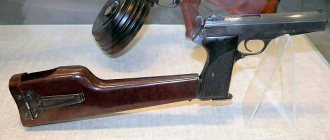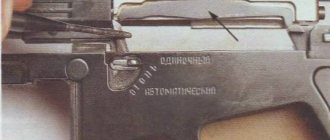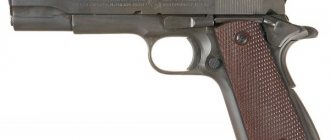The era of modern automatic (self-loading) pistols is usually counted with the appearance of the first Browning pistol, the M1900. It was John Browning who, at the beginning of the 20th century, patented the automation schemes that are the most common to this day. What happened before Browning?
- Tubular Volcanic. Reload with one left
- Laumann pistol. How an accidental shot led to the discovery of automation
- Officer and Archduke. Why didn't the first automatic pistol become the first?
- Clumsy and reliable. What does the Borchardt have in common with the Mauser and Parabellum?
- "Mannlicher" - a pistol without a bolt and an "Austrian Mauser"
- What Glock borrowed from Karel Krnka's pistol
As a rule, memory only suggests the famous “Mauser” K96; a little later the “Luger” (aka “Parabellum”) appeared. In fact, even before the Mauser, five models of automatic pistols were mass-produced in Europe. And some of the technical solutions used in them are used in systems of the 21st century.
Tubular Volcanic. Reload with one left
Until the end of the century before last, the revolver unconditionally dominated the world of short-barreled weapons. From time to time, designers tried to create versions of multi-shot non-automatic pistols, where reloading would be carried out using the muscular strength of the shooter. But it was like reinventing the wheel - each time non-viable monsters were born who were obviously inferior to the revolver in all respects.
One of the most successful attempts to come up with an alternative to the proven rotating drum system was the American Volcanic pistol from Smith & Wesson, introduced in 1854. It used an under-barrel tubular magazine and an original caseless ammunition that housed the powder and primer inside a hollow, conical bullet. The Volcanic was reloaded by moving the trigger guard, equipped with a special ring for the finger. This is very similar to reloading Winchester rifles with a Henry brace. The only difference is that when shooting from a rifle, working with the brace is easy and convenient - you hold the weapon with both hands and can reload without removing it from your shoulder. With a pistol, everything turned out to be much more complicated - it was very difficult to reload it with one hand, but to constantly operate with both hands... it would be easier to take a full-fledged rifle then.
Our days
Among the variety of modern types of hand-held small arms, two categories already discussed should be distinguished, but within their framework there are samples that differ in purpose, caliber, methods of shooting and aiming. Trends in the development of this type of small arms are mainly related to the requirements of army special forces, police and, in a number of countries, private use.
The main areas of development are reducing recoil when fired, ease of use, rate of fire, concealed wearing, the use of composite materials and alloys to reduce the weight of weapons, multi-charging, and full automatic firing. While maintaining design features, pistols become more compact and lighter.
In addition to combat ones, varieties of sporting and hunting pistols and revolvers appeared.
Laumann pistol. How an accidental shot led to the discovery of automation
In general, the lever reloading scheme in relation to the pistol turned out to be so-so, nevertheless, designers experimented with it on both sides of the Atlantic. One of these experimenters was the Austro-Hungarian gunsmith Joseph Laumann, who created his own version of a lever pistol, but not with a tubular, but with a box magazine for five rounds, which was placed like a rifle - in front of the trigger guard. The longitudinally sliding bolt of the pistol also resembled a rifle. The whole design was so far from perfect that it once fired in the hands of the inventor with the bolt not fully closed. However, nothing terrible happened, the spent cartridge simply threw the bolt back, hit the reflector and flew out. Perhaps a random shot is only a legend. However, if you believe her, then it was this incident that gave Lauman the idea of converting a lever pistol into an automatic one. All that remained was to remove the unnecessary bracket, install the return spring and calculate the force of the spring and the mass of the bolt so that the recoil occurred after the bullet left the barrel. This is how the first pistol with a (conditionally) blowback bolt was invented - such a scheme with serious modifications was later patented by John Browning.
Why successful pistol designs could turn out to be dead ends
The Laumann pistol was loaded using a metal pack, like the Austrian Mannlicher rifle. To discharge, you had to press a metal button, and the pack would fly up, while the empty pack itself would fall down through a special window. The bolt was cocked by a massive lever on the right side. The total length of the pistol was 228 mm, the barrel length was 142 mm, and the weight was more than 1 kg.
The world's first automatic pistol went into production under the name Schönberger M1892 (Schönberger model 1892, apparently after the name of the manufacturer). The caliber of the pistol was 7.8 mm, but not a single cartridge has survived to this day, not even the characteristics of the ammunition have been preserved. Only a few dozen Schönberger M1892s were produced. In 1896, these pistols were tested by the Austrian military, but were rejected.
"Colt 1911"
0
The US military, despite its historical love for revolvers, understood that self-loading pistols had a number of undeniable advantages. Therefore, before the First World War, the issue of replacing army revolvers with semi-automatic pistols became acute. The peculiarity of the American competition for a new pistol was that the US military certainly wanted to get a large 45 (11.43 mm) caliber pistol. Browning, working for , for the competition modified his 38-caliber (9 mm) model for the cartridge so desired by the Americans. In 1911, the Browning self-loading pistol was adopted under the designation “Colt mod. 1911" (eng. Colt M1911). This is how the legendary pistol was born, which served in the richest army for more than 70 years, sold all over the world with a total circulation of more than 3 million units and is actively produced to this day by many weapons companies. Structurally, it was a pistol with a single-action open hammer, power was supplied from a 7-round magazine placed in the handle. There was an additional safety on the back of the handle. Characteristics Weight - 1.106 kg unloaded, 1.256 kg with cartridges. Length - 206 mm. Caliber - 45 (11.43 mm). Magazine capacity - 7 rounds. The initial bullet speed is 246 m/s. The Colt did not have the aesthetics and accuracy of a Parabellum or the range of a Mauser, but in all its characteristics it was the best military pistol of the First World War, and also very powerful. In addition to the US Army, Colt 1911s were used by all belligerents. And this is despite the strong recoil, limited ammunition and short firing range.
0
In 1926, the M1911 was slightly modernized. The new model received the index “M1911A1” and, without any special changes, served as the main pistol of the US Army until the mid-1980s. It is still actively used in many special forces of the army and police around the world.
Officer and Archduke. Why didn't the first automatic pistol become the first?
The Salvator-Dormus pistol of 1891, designed by the Archduke of Austria-Hungary Karl Salvator and the Austrian officer Georg von Dormus, is challenging Laumann's leadership. In 1891, these gentlemen received a patent for the world's first automatic pistol, noting that the scheme they developed could also be used in rifles. The patent was accompanied by detailed drawings of the weapon. The problem was that until 1895, the Salvator-Dormus pistol existed exclusively on paper: the designers understood the imperfections of their system and actively refined it. But in 1892, the Archduke died of influenza, and Doremus had to finish the weapon alone. In 1895, several samples of five-shot pistols were assembled, which even in appearance were noticeably different from the images in the early drawings. The Salvator-Dormus pistol participated in the competition for armament of the Austro-Hungarian army in 1897, but lost to the Hesser revolver of the 1870 model.
Hard worker revolver
0
At the end of the 19th century, massive rearmament of the army began in Russia. In parallel with the choice of a rifle (the winner of the competition was the famous three-line Mosin model of 1891), a competition was announced for a new revolver. The winner was the Nagan brothers arms factory, located in the Belgian city of Liege. The Russian military presented a number of demands. So, the caliber of the pistol had to correspond to a rifle - 7.62 mm. At the same time, the revolver had to have sufficient destructive power, good accuracy of fire and weigh in the range of 800-900 g. And also be easy to use, technologically advanced in production and reliable in operation. Surprisingly, all these requirements were implemented in the Nagan system revolver. In 1893, the revolver was adopted by the Russian army in two versions - soldier and officer. The latter featured self-cocking, while the former did not (to simplify the design and reduce cartridge consumption). Characteristics Weight - 0.795 kg unloaded, 0.880 kg with cartridges. Length - 220 mm. Caliber - 7.62 mm. Drum capacity - 7 rounds. The initial bullet speed is 272 m/s. The Nagan system revolvers turned out to be so successful that they became widespread throughout the world - from Argentina to Vietnam. Nagants were produced both in Belgium itself and in Russia, Poland and other countries. The total circulation of the pistol was more than 2 million pieces, the largest number of which were used in Russia and the USSR.
0
Even after the advent of more powerful, faster-firing and advanced semi-automatic pistols, the revolver for a long time enjoyed well-deserved love for its unpretentiousness, reliability, the ability to fire after a misfire and high accuracy. During World War II, revolvers were produced in parallel with the TT and were widely used by both the Red Army and the Wehrmacht in the form of trophies.
Clumsy and reliable. What does the Borchardt have in common with the Mauser and Parabellum?
The second model embodied in metal and the first truly successful automatic pistol is considered to be the sample of the German Hugo Borchardt Borchardt C93 (“Borchardt” K93). Its automation used a short barrel stroke; the bolt was locked using a system of levers, which, when the bolt was locked, were in the so-called dead center position. A detachable box magazine for 8 rounds of 7.65x25 mm was located in the handle.
Why “legendary” pistols of the 20th century are often overrated
The design turned out to be very reliable and immediately received a number of rave reviews. The pistol was patented in ten countries, including England, Germany, France, and the USA. True, no one was in a hurry to take it into service: due to the protruding butt plate of the frame, the weapon was huge and awkward. With a barrel length of about 19 cm, the Borchardt K93 had a total length of more than 35 cm. But it was a success in civilian life - among hunters and travelers. Moreover, the weapon was equipped with an attached butt and could be used as a light carbine. Three years later, the concept of a pistol-carbine would be used by the creators of the famous Mauser K96.
And Borchardt's pistol very soon fell into the hands of the Austrian gunsmith Georg Luger. He modified the design (in particular, by simplifying the locking mechanism, thanks to which the protruding “heel” disappeared), increased the tilt of the handle, and as a result, in 1898, an extremely successful, compact and elegant pistol appeared, which in Russia became known under the commercial name “Parabellum” .
Tula Tokarev
0
Another sibling of the M1911 and the Browning HP, the TT pistol was developed in the USSR by gunsmith Fedor Vasilyevich Tokarev for a competition to replace the revolver with a new self-loading pistol. It will be difficult for an untrained person to find even a couple of differences between the TT and the Browning FN M1903. However, there was no talk of complete copying. The most important difference was the use of a very powerful 7.63x25 Mauser cartridge with a high muzzle velocity. The Russian military, as in the case of the revolver, wanted to have a weapon that was unified, if not in terms of cartridge, then at least in terms of caliber. Thus, in the USSR, defective barrels for Mosin rifles were used to make barrels for revolvers and TTs, and subsequently for PPSh. Very practical in conditions of total war! Characteristics Weight - 0.854 kg uncharged. Length - 195 mm. Caliber - 7.62 mm. Magazine capacity - 8 rounds. The initial bullet speed is 420 m/s. In the early 1930s, the TT, along with a modified 7.62x25 cartridge, was put into service. The army has begun actively replacing the outdated revolver with new TTs. As testing and operation progressed, shortcomings were identified and work was constantly carried out to improve the design. Thus, a model was developed with a longer handle and a 12-round magazine. But its implementation was prevented by the outbreak of war. In 1942, an experimental batch of TTs was produced with a two-row magazine for 15 rounds. But the main measures during the war years were aimed not at improving performance, but at simplifying the design and increasing the manufacturability of production. From this point of view, the TT was superior to imported pistols. It consisted of fewer parts, was easy to assemble and disassemble, and could be produced on low-quality equipment by less qualified workers and even children.
0
Alas, “tete” were not highly reliable. The kit even came with a spare barrel! Production of the pistol continued until 1952, after which the Makarov pistol replaced the TT. In the 1990s, TTs again became very popular, especially in criminal structures and some special forces of the Ministry of Internal Affairs and the FSB. Today the pistol can be found in all hot spots of the planet. It is valued for its compactness, low cost and powerful cartridge, capable of penetrating most second-class body armor
"Mannlicher" - a pistol without a bolt and an "Austrian Mauser"
Next in line is the Mannlicher 1894 pistol. The peculiarity of its design was that it did not have a shutter at all. During the shot, the frictional force between the bullet and the barrel pulled the barrel forward; when it reached the extreme forward position, the spent cartridge case was ejected, and a new cartridge from the magazine was fed upward, after which the barrel, under the action of the return spring, was itself seated on the cartridge. Like most early models, the Mannlicher had a permanent magazine with a capacity of only 5 rounds, which were loaded from above using a clip.
The Mannlicher 1894 participated in a competition for short-barreled weapons for the army, but this system did not have any clear advantages over revolvers. As a result, the competition was lost. But the designer did not give up, and in 1896 he introduced a new model of a short barrel - the Mannlicher M96. True, this pistol, both in design and design solutions, was reminiscent of the recently appeared German “Mauser” K96, and it was called the “Austrian Mauser”. The Mannlicher M96 had a ten-place magazine with a double-row arrangement of cartridges, like on a Mauser. And even the cartridges were similar to the Mauser ones, only with a reduced powder charge.
Classics of the genre
The description and characteristics of various types of pistols and revolvers deserve not just an article, but a multi-volume publication. Let's look at the most famous and well-known ones. The hit parade of famous models opens:
Lepages are French flintlock pistols designed by Jean Le Page, produced in sets. Due to the all-Russian fame of the novel by A.S. Pushkin "Eugene Onegin". The poet’s fatal duel, interestingly, took place on Karl Ulrich’s percussion pistols.
Colt is a surname that has become a common noun for most revolvers. American pistols are an integral attribute of police weapons in many countries; the most famous is a pistol designed by Browning, but produced by the Colt factory - M1911 .45 caliber.
Other famous US revolvers and pistols:
- Smith-Wesson arr. 1871 (an American revolver that was in service with the Russian army, which is why it received the designation “Russian”);
- Colt M1911 - it is this pistol (more precisely, its designer Joseph Moses Browning) that history owes to the main design features of self-loading pistols.
Nagan is a similar, but European story. Patented by the Belgian gunsmiths - the Nagan brothers, the revolver entered service with some armies, thanks to one interesting new product. Nagans solved the problem of the breakthrough of powder gases between the barrel and the cylinder of a revolver. Before firing, the drum moved towards the barrel, and the muzzle of the cartridge case entered its channel.
German pistols are a whole galaxy in the small arms universe. The first number was the Mauser S-96, mentioned above. But the most popular were the German pistols of the Second World War of the Walter and Luger brands. Of course, these are also the names of the designers.
But what’s interesting is that the Prabellum, which has become a symbol of the German army, is one of the Luger models. The modification for artillery units with a long barrel looks especially impressive.
Walter is better known as a James Bond weapon (PPK model), but in the modern world it is in demand both in the army and police forces.
You can also talk for a long time about USSR pistols. The first example of combat pistols from the Country of the Soviets was the famous TT (a project by designer F.V. Tokarev), created in 1929 in order to replace models of foreign weapons.
Other classic models are the Makarov pistol (PM) and the Stechkin automatic pistol (APS), which are in service with the army and law enforcement units.
Currently, a number of bright and talented designers have emerged - Yarygin with his PYa ("Rook"), for example, in addition, pistols created by teams of authors have appeared - GSh-18 and others.
Weaponry schools in Switzerland, Austria and Italy are also known. Beretta, ZiG and Glock pistols occupy the top ranking of modern weapons.
Revolvers have given way to pistols in the military, but they are still widespread in the civilian market and among the police. Moreover, the French special forces use revolvers as additional weapons, this is due to their high power and the fact that in the event of a misfire, the revolver does not require manipulation by jerking the bolt.
Special purpose Steyer, caliber .38 (9 mm)
The 9 mm special purpose Steyer is generally similar to the Steyer Tactical Machine Pistol (TMP), but the latter, despite its name, belongs to the category of submachine guns. The body of the weapon and its coating are made of composite materials, there is no front handle, like a machine gun, although the forend is somewhat elongated so that the fingers are further away from the barrel. The pistol fires 9x19 mm Parabellum cartridges only in self-loading mode. The cocking lever is located at the rear. The automatic pistol operates due to the short stroke; trunk...
Read more
Walther P38 (Germany)
The P38 pistol was developed back in the second half of the thirties specifically as an army pistol. Its first user was Sweden, which purchased a small number of Walther HP pistols (Heeres Pistole, that is, army pistol) in 1938; in 1940, under the official designation Pistole 38, it was adopted by the Wehrmacht and was widely used during the Second World War. The production of P38 pistols continued immediately after the end of the war in 1945-46, from military stocks, and was carried out under the supervision of the French occupation authorities. In the mid-1950s, the Carl Walther company began to rise from its post-war ruins.
In 1957, the Bundeswehr adopted the P1 pistol, which differed from the first P38 only in its aluminum frame. At the same time, the commercial version of the same pistol was still called P38. Production of commercial steel frame P38 pistols in the post-war period was fairly small. In 1975, a reinforcing hexagonal cross-section rod was introduced into the design of the P1/P38 pistols, located in a frame in the area where the barrel locking cylinder is located. In the early 1970s, to unify and modernize the very diverse fleet of pistols of the German police, the P4 pistol was developed and approved for use, which was a modification of the P1/P38 pistol with a shortened barrel and a modified safety mechanism. P4 pistols remained in production until 1981, being superseded by the more advanced Walther P5 model.
Browning .32 caliber (7.65 mm) Model 1910
After acquiring Browning's patents, the Model 1910 pistol was developed, which was initially chambered for the 7.65 x 17 mm Browning cartridge, but was later chambered for the 9 x 17 mm cartridge. This weapon uses the recoil principle of a free bolt, and its recoil spring is located on the barrel and locked in the casing with a special coupling, as a result of which the appearance of the pistol is quite unusual and easily recognizable. On the handle of the weapon there is a safety key in the form of a key. The Model 1910 was not a success with the military, although...
Read more
1 more >
Browning Model 1900
This model is slightly different from the “Old Model”, and since some facts from the history of this pistol are known, it was decided to include it in the book. Browning 1900 - the first self-loading pistol of the famous American John Browning, which began to be produced in large quantities; it is sometimes called the "Old Model". This pistol fired cartridges that Browning originally developed specifically for this weapon. Currently, these cartridges are widely used in various self-loading pistols. ...
Read more
Tomiska "Little Tom"
The famous gunsmith from Vienna Alois Tomiska developed a self-loading pistol, which he patented in 1908 under the name “Little Tom”. It has a fixed barrel and a bolt-casing without a top part. The return spring is located in a sleeve under the barrel. The trigger mechanism is double action; thus, the hammer can be cocked by pulling the bolt back or by pressing the trigger. Most of the trigger is in a recess at the rear of the body, but there is a knurled comb protruding upward that allows for thumb cocking. ...
Read more
